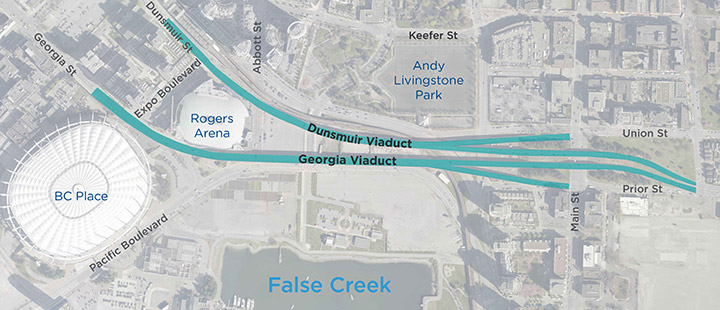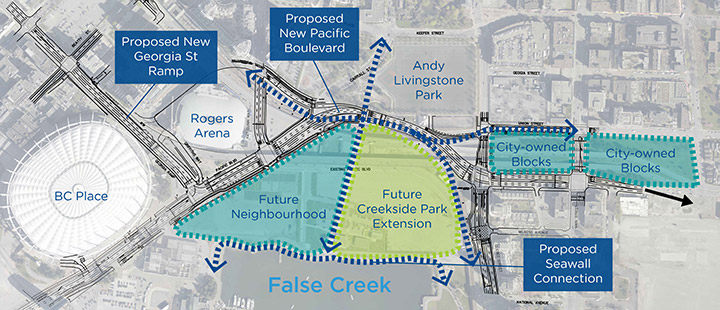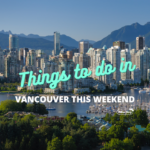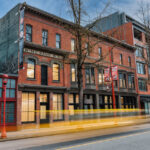Vancouver to Remove Viaducts
byLast night, Vancouver City Council voted in favour of tearing down the Georgia and Dunsmuir viaducts. “This is a once-in-a-generation city-building opportunity,” said Mayor Gregor Robertson in a written statement.
The vote on Monday night meant staff will start detailed planning and land negotiations, and will report back to council in 18 months with an update. The plan to remove the viaducts includes an increase in downtown park space. It also includes two new city blocks that would be used for social and market housing. (Source: CBC Vancouver)
Before (Now)

After

In the Mayor’s statement he said: “There is no decision at the city that has been more scrutinized, studied, deliberated or consulted on than whether or not to remove the viaducts, and after four years, it is time to move forward.”
Vancouver Viaduct History
Vancouver has had viaducts in place, in that area, for close to 100 years. On July 1st, 1915, the first Georgia viaduct opened for streetcar use. It extended over the CPR’s Beatty Street yard and it was named the “Hart McHarg” bridge after a World War I hero. Apparently the viaduct was so poorly constructed that within a few years of it going up, chunks began to fall on, endangering pedestrians below.

1913 – Georgia viaduct under construction. Imagine Rogers Arena to the right, BC Place to the left.
Vancouver Archives item# CVA 99-1303. Photographer: Stuart Thomson

1915 – Georgia Harris Street viaduct opening. Vancouver Archives item# PAN N100B. Photographer: W.J. Moore

1915 – Car on the Georgia Viaduct, Sun Tower in the background. Archives# CVA 99-18.
It wasn’t until 1963 that, under the leadership of Bill Rathie (the first mayor of Vancouver that was actually born in the city), a 20-year program was drawn up that would involve redevelopment, transportation solutions, low-cost housing, and a downtown revitalization. A new Georgia viaduct was thought up for cars to allow easier access to downtown.
But the replacement viaduct in the 1960’s and into the 1970’s was also part of a larger plan. There was a movement to build a freeway system right into and through downtown Vancouver. Can you imagine Highway 1 ploughing right through East Vancouver, Strathcona, and Chinatown? This was the grand idea and it was thought that the viaducts would nicely connect the freeway to the city’s centre.

Between 1971 & 1981 – Georgia and Dunsmuir viaducts from the air. Vancouver Archives item# CVA 780-8.
Before the freeway plans were solid, buildings were being razed in anticipation. This included the Hogan’s Alley community, which was bulldozed to make room for the new Dunsmuir and Georgia viaducts. Buildings on the East side were reduced to rubble and wiped off the city map — and this is where residents stepped in. Strathcona community activists created much opposition to the grand plan and ended up saving their corner of the city.
Looking ahead, you can view the proposal for removal on the City of Vancouver’s website along with a series of information boards.










4 Comments — Comments Are Closed
For me, this is a very sad day, as that is the only route I ever take into downtown, and it allows me to have quick, direct access. Not to mention, the view on my way in is my favourite view of downtown Vancouver. I’m very sad about this, and hope council doesn’t live to regret this decision. Thanks Mr. Mayor. 🙁
Miserable decision
There was so much the city could’ve done with the viaducts but it had to bow to developer greed and desire to further transform parts of Vancouver into a vertical suburb.
Beneath those viaducts could’ve been a rain covered flea market or still, a park extention featuring shade requiring flora. The developers could’ve been influenced into producing daring engineering and architecture to fit structures into the existing space between and around the viaducts. The surface of the viaducts could’ve been transformed or reclaimed as a green space and direct bike and walk walkway into the heart of the city with gorgeous views
Vancouver used to be an exciting and daring city at the forefront ofurban design but now it seems the city is more keen on becoming a basic resort town like Banff to service developers and the interests of the wealthy than being something at the forefront of urban living.
A god damn shame.
Thank gawd. I take the viaduct frequently when travelling by car downtown, but honestly people, stop being sticks in the mud. That whole corridor is an eyesore and probably is a major contributor to the DTES being so cut off from the rest of the city in so many ways. The viaduct was constructed for a freeway that was never even built. Talk about mis-management! Not to mention the thinking around car-centric design of cities is long since past. Vancouver needs to look to the future, not the past. The viaducts will be gone an nobody will even remember they were there and the whole area will grow as a result. Its impossible to imagine the area being worse than it is now. Thankfully some Vancouver councillors are not afraid to make decisions and move the city forward.
This is a decision made by a city council who have an unrealistic vision of a no car city. Indeed, the very problem and eyesore they are trying to eliminate (traffic) is a problem they are inviting. The viaducts are not pretty nor is any highway infrastructure but without it cars and trucks are forced on to city streets where residents and businesses have to look at the unsightly congestion. The issue that is being ignored is that the viaducts (and highway infrastructure in general) are the conduits of commerce ie: the movement of goods. Any product in a store downtown needs to get there via a truck. There are over 10,000 trucks a day transporting goods downtown and now they will be on surface level streets…not good!
In city council’s pursuit of utopia (the car free city), they have in fact created dystopia.